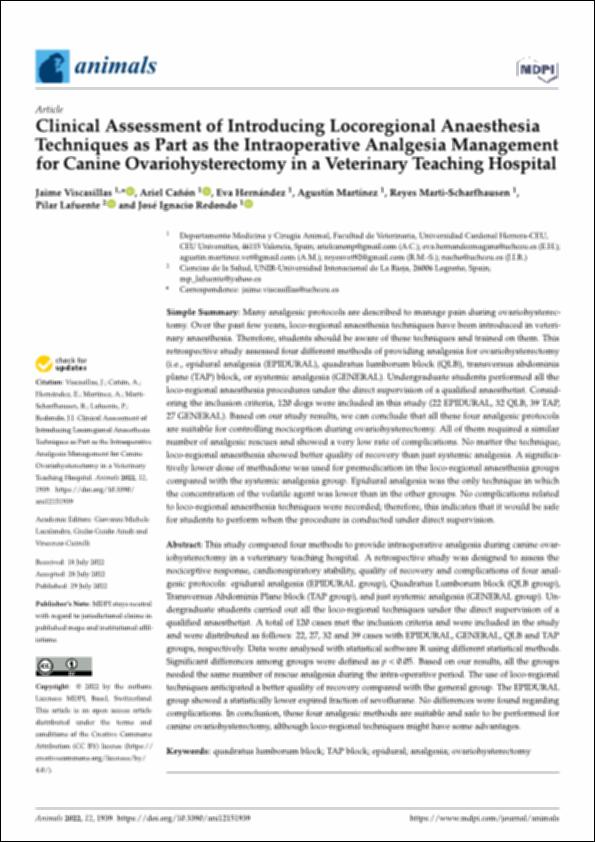Por favor, use este identificador para citar o enlazar este ítem:
http://hdl.handle.net/10637/14193Clinical assessment of introducing locoregional anaesthesia techniques as part as the intraoperative analgesia management for canine ovariohysterectomy in a veterinary teaching hospital
| Título : | Clinical assessment of introducing locoregional anaesthesia techniques as part as the intraoperative analgesia management for canine ovariohysterectomy in a veterinary teaching hospital |
| Autor : | Viscasillas Monteagudo, Jaime Cañón, Ariel Hernández, Eva Martínez, Agustín Martí-Scharfhausen Sánchez, María de los Reyes Lafuente Baigorri, Pilar Redondo García, José Ignacio |
| Materias: | Perros - Aparato genital - Cirugía.; Dogs - Generative organs - Surgery.; Perros - Anestesia.; Anestesia veterinaria.; Dogs - Anesthesia.; Ovaries - Surgery.; Anestesia local.; Local anesthesia.; Ovarios - Cirugía.; Veterinary anesthesia. |
| Editorial : | MDPI |
| Citación : | Viscasillas, J., Cañón, A., Hernández, E., Martínez, A., Marti-Scharfhausen, R., Lafuente, P. & Redondo, J. I. (2022). Clinical assessment of introducing locoregional anaesthesia techniques as part as the intraoperative analgesia management for canine ovariohysterectomy in a veterinary teaching hospital. Animals, vol. 12, i. 15 (29 jul.), art. 1939. DOI: https://doi.org/10.3390/ani12151939 |
| Resumen : | This study compared four methods to provide intraoperative analgesia during canine ovariohysterectomy in a veterinary teaching hospital. A retrospective study was designed to assess the nociceptive response, cardiorespiratory stability, quality of recovery and complications of four analgesic protocols: epidural analgesia (EPIDURAL group), Quadratus Lumborum block (QLB group), Transversus Abdominis Plane block (TAP group), and just systemic analgesia (GENERAL group). Undergraduate students carried out all the loco-regional techniques under the direct supervision of a qualified anaesthetist. A total of 120 cases met the inclusion criteria and were included in the study and were distributed as follows: 22, 27, 32 and 39 cases with EPIDURAL, GENERAL, QLB and TAP groups, respectively. Data were analysed with statistical software R using different statistical methods. Significant differences among groups were defined as p < 0.05. Based on our results, all the groups needed the same number of rescue analgesia during the intra-operative period. The use of loco-regional techniques anticipated a better quality of recovery compared with the general group. The EPIDURAL group showed a statistically lower expired fraction of sevoflurane. No differences were found regarding complications. In conclusion, these four analgesic methods are suitable and safe to be performed for canine ovariohysterectomy, although loco-regional techniques might have some advantages. |
| Descripción : | Este artículo se encuentra disponible en la siguiente URL: https://www.mdpi.com/2076-2615/12/15/1939 Este artículo pertenece al número especial "Recent Advances in Companion Animals Neutering". |
| URI : | http://hdl.handle.net/10637/14193 |
| Derechos: | http://creativecommons.org/licenses/by/4.0/deed.es |
| ISSN : | 2076-2615 (Electrónico) |
| Idioma: | es |
| Fecha de publicación : | 29-jul-2022 |
| Centro : | Universidad Cardenal Herrera-CEU |
| Aparece en las colecciones: | Dpto. Medicina y Cirugía Animal |
Los ítems de DSpace están protegidos por copyright, con todos los derechos reservados, a menos que se indique lo contrario.


